There tends to be a generalized belief that cats hate water because they can’t swim.
However, cats are decent swimmers if the need arises, but that doesn’t mean all felines like to take a plunge. Regardless of whether your cat enjoys water or not, water safety and proper cat care should be a top priority.
Cats can swim, but if they can’t find a suitable exit point, water can pose a hazard. Cats that don’t like the water typically haven’t been exposed to it or don’t like how it waterlogs their fur.
Certain feline breeds loathe water and get wet, while others, like Turkish Angoras and Maine Coons, absolutely love it.
Sometimes, domestic cats simply don’t have a lot of early experiences with water, making them somewhat anxious around it.
This often stems from the common misconception that all cats hate water or can’t swim, so cat owners avoid it.
However, by introducing your cat to water in an appropriate way, your feline friend might find it rather enjoyable.
Can All Cats Swim?
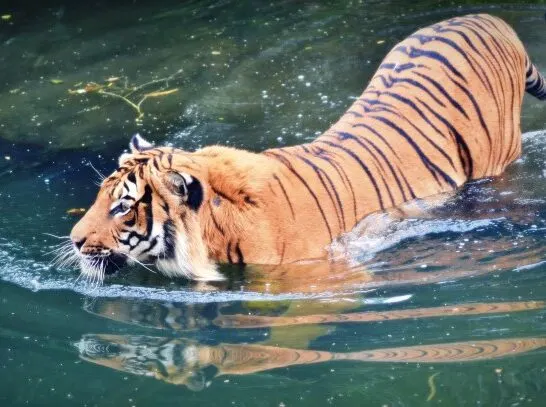 Many large cat breeds, like tigers and cougars, can swim fast and for long distances. So, why do so many people assume that domestic cats don’t swim?
Many large cat breeds, like tigers and cougars, can swim fast and for long distances. So, why do so many people assume that domestic cats don’t swim?
Well, it’s likely because you don’t see it very often, and it’s true, many cats don’t like water.
But all cats, like many other animals, possess a natural instinct to swim that springs from a survival instinct. Therefore, if a cat falls into a pool, it will have a natural inclination to start paddling.
But, this doesn’t mean your cat necessarily wants to swim for fun. Still, even if all cats have a natural ability to swim, some are more graceful at it than others.
Again, your cat isn’t necessarily trying to become a champion swimmer; they’re just trying to keep their head above water.
Will A Cat Drown If They Fall In Water?
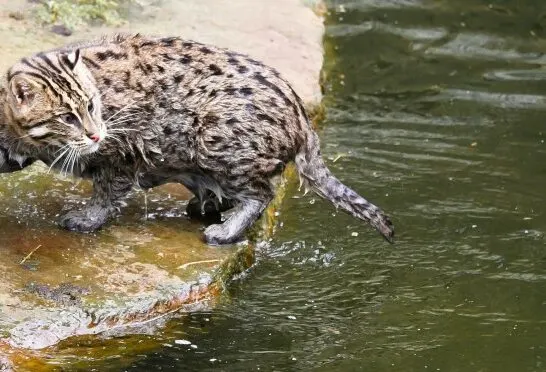 The reason for most drownings or near-drownings involving cats is that they can’t find a way out of the water. Or, if the cat has any particular physical limitations, is older, or is injured, it can struggle in the water.
The reason for most drownings or near-drownings involving cats is that they can’t find a way out of the water. Or, if the cat has any particular physical limitations, is older, or is injured, it can struggle in the water.
These specific circumstances can make it challenging for a cat to maintain their paddling and keep their head above water.
If Cats Can Swim, Why Do So Many Seem To Hate Water?
When you think about it, many people can do things that they don’t actually like to do.
For example, you might hate jogging, but you can still do it. The same goes for cats; many breeds simply prefer to stay high and dry.
Waterlogged Fur
 The primary reason so many cats dislike water is what water does to their coats. When their coats get submerged, for many cats, it waterlogs their fur and can send them into a panic.
The primary reason so many cats dislike water is what water does to their coats. When their coats get submerged, for many cats, it waterlogs their fur and can send them into a panic.
This is because the added weight of the water makes them heavier, and it’s harder for them to move around.
Cats don’t like to feel trapped. A soaked coat makes them feel like they can’t get away fast enough if they need to. It can also make it more of a struggle to keep swimming and stay afloat.
Plus, it also makes it harder for them to move around on land. Others, they might hate getting submerged but still enjoy splashing in a water dish or playing in the fishbowl.
No Exposure To Water
Still, for other felines, fear or apprehension regarding water can simply be a matter of not being used to it.
Unlike dogs, which many people tend to expose to water early on, cats don’t get the same treatment. This is due to a mixed-up message that all dogs love water and all cats hate it.
It’s similar to the stereotype that cats always drink milk; however, cats shouldn’t drink a lot of milk.
When it comes to swimming, many cats can swim circles around their canine counterparts; several dog breeds are horrible swimmers.
Bad Experiences With Water
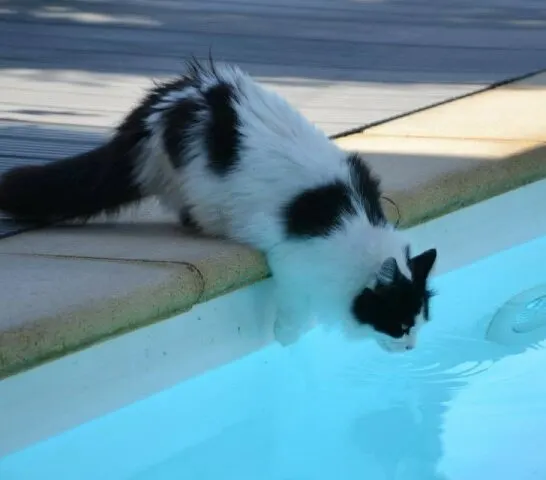 For some cats, their fear of water can develop from past experiences.
For some cats, their fear of water can develop from past experiences.
For example, your cat might have been abandoned by a previous owner in the rain. Or, a passing car sped through a puddle, startling and splashing your cat.
Perhaps your cat fell into the pool and couldn’t find a way out. Therefore, they started to panic before you pulled them to safety.
All of these negative experiences surrounding water can contribute to a cat’s fear of it.
16 Cat Breeds That Like The Water
There are quite a few breeds of cats that love the water and have a natural affinity for it. Others tend to develop a love for water because of a need for frequent baths, like the Sphynx.
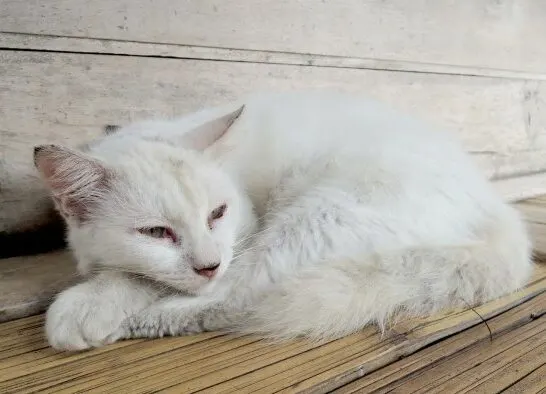 Here is a list of some cats that won’t typically shy away from water.
Here is a list of some cats that won’t typically shy away from water.
- Turkish Angora
- Maine Coon
- American Bobtail
- Turkish Van
- Siamese
- Savannah
- Sphynx
- British Shorthair
- American Shorthair
- Highlander
- Abyssinian
- Manx
- Japanese Bobtail
- Bengal
- Norwegian Forest Cat
- Egyptian Mau
There are even a few cats that will go above and beyond playing in the water and actually enjoy a swim.
For example, breeds like the Norwegian Forest Cat, Turkish Angora, and Maine Coone have more water-resistant coats.
Thank to this water-repellent quality, their coats don’t get waterlogged, allowing these cats to enjoy their splash time better.
How Do You Teach A Cat To Swim?
 Yes, you can teach a cat to swim and enjoy the water. However, if your cat doesn’t show any interest after your attempts, don’t force the issue.
Yes, you can teach a cat to swim and enjoy the water. However, if your cat doesn’t show any interest after your attempts, don’t force the issue.
If you want to try, start slow and steady and gradually increase the amount of water exposure. Also, remember that patience is a must.
Step One: Let Your Cat Investigate the Water (Supervised)
Allow your cat the opportunity to see the water, investigate it on their own, sniff it, etc. You can have treats on hand to give your cat to help associate positive experiences with the water.
You can either leave the bathroom door open while you take a bath or sit in a kiddie pool in the backyard. When your cat approaches, give them a treat and talk calmly and positively.
Make sure not to pet your cat with wet hands; this could freak them out.
Step Two: Bring Your Cat In The Water
After your cat seems to be okay with being near the water and more curious, you can move forward. Pick up your cat and see if you can sit in the tub or kiddie pool with them. If they start to panic, stop and reverse.
But, if they remain somewhat calm, gently sit in the water and just let a small part of your cat get wet. In other words, their back feet and legs might be in the water but nothing else. Keep talking in a soothing voice to your cat and give them tasty treats.
Repeat this several times over several sessions, gradually putting more of your cat’s body into the water. But always keep their head above water.
Step Three: If Your Cat’s Ready, Let Them Swim
Once your cat seems comfortable being in the water with you, loosen your hold. This lets your cat move away from you if they desire to do so. However, it’s essential that you stay close.
Despite having a natural survival instinct to swim, you should not leave your cat alone in the water.
Watch your cat carefully, and if they start to show signs of distress, get them out of the water immediately. Also, have a towel on hand to dry them completely.
Safety Tips For Cats And Water
- After a swim, ensure your cat gets dry, including their ears. Leaving water in your cat’s ears can lead to inflammation and other issues.
- Don’t ever assume your cat will be fine around water. Keep pools and hot tubs covered at all times.
- Always monitor your cat when they are swimming.
- Don’t ever force your cat to get into the water.
- Start exposing your cat to water when they are an older kitten, so they are used to it.
- If you have a pool, ensure you keep the chemicals at the appropriate levels.
- You might want to add extra Omega-3s and fatty acids to your cat’s diet if they swim a lot. Too much water can strip the natural oils from their coat, causing them to dry out. You can ask your vet for recommendations.
Related Questions
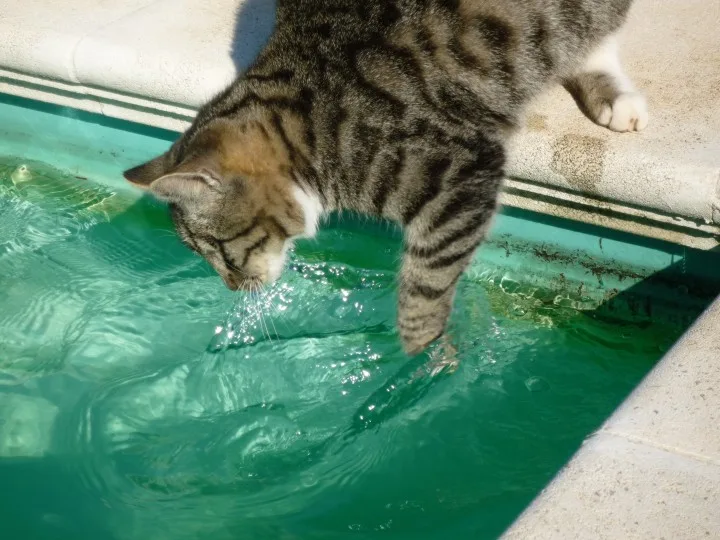 Are kittens able to swim?
Are kittens able to swim?
Young kittens might try to paddle and swim if necessary. But they might not yet have the coordination and strength to do so well, if at all.
Therefore, young kittens will be more susceptible to drowning. It’s best to wait till kittens are older to start exposing them to water.
What are the signs of distress if my cat breathes in water or almost drowns?
If your cat is involved in a near-drowning incident or your suspect they inhaled water into their airways, look for these signs:
- A very rapid or very slow heart rate
- Rapid or slow breathing
- Excessive abdominal movement while they are breathing
- Bluish or pale gums
- Unconsciousness
- Coughing or gagging
If your cat exhibits any of these signs, get them to your vet or an animal emergency clinic immediately. If you’re unsure, take them to the vet.
Can cats swim underwater?
No, cats don’t swim underwater. They have a natural instinct to paddle and swim with their head above the surface.
Never force your cat to go underwater. They will likely ingest or breathe in water and could end up in severe distress or drowning.
If your cat falls into a pool or other body of water and goes under, get them out immediately. It’s best to bring them to the vet to have them checked out if this happens. In some cases, there could be water blocking their airways, even in tiny amounts.
Stacy is a lifelong animal lover who truly believes life just isn’t complete without pets. She’s had pets her whole life (including three dogs and a cat living under the same roof, somewhat harmoniously). She currently resides in NOLA with her husband, son, and two pups, Scooby “Dooby” Doo and Zoey. Stacy always makes a point to learn everything she can about her fur babies, and she has been writing about the pet-parent life for over two years.

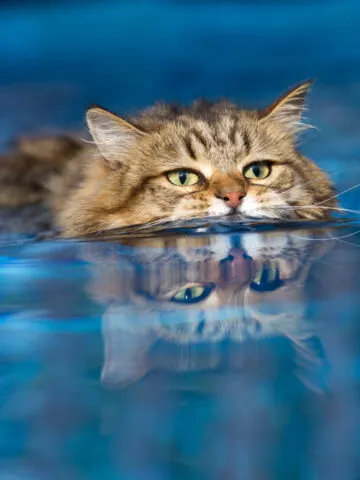

Leave a comment
You must be logged in to post a comment.